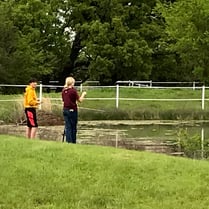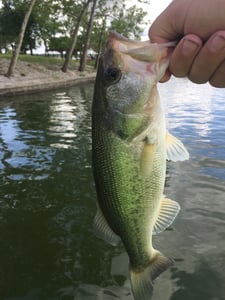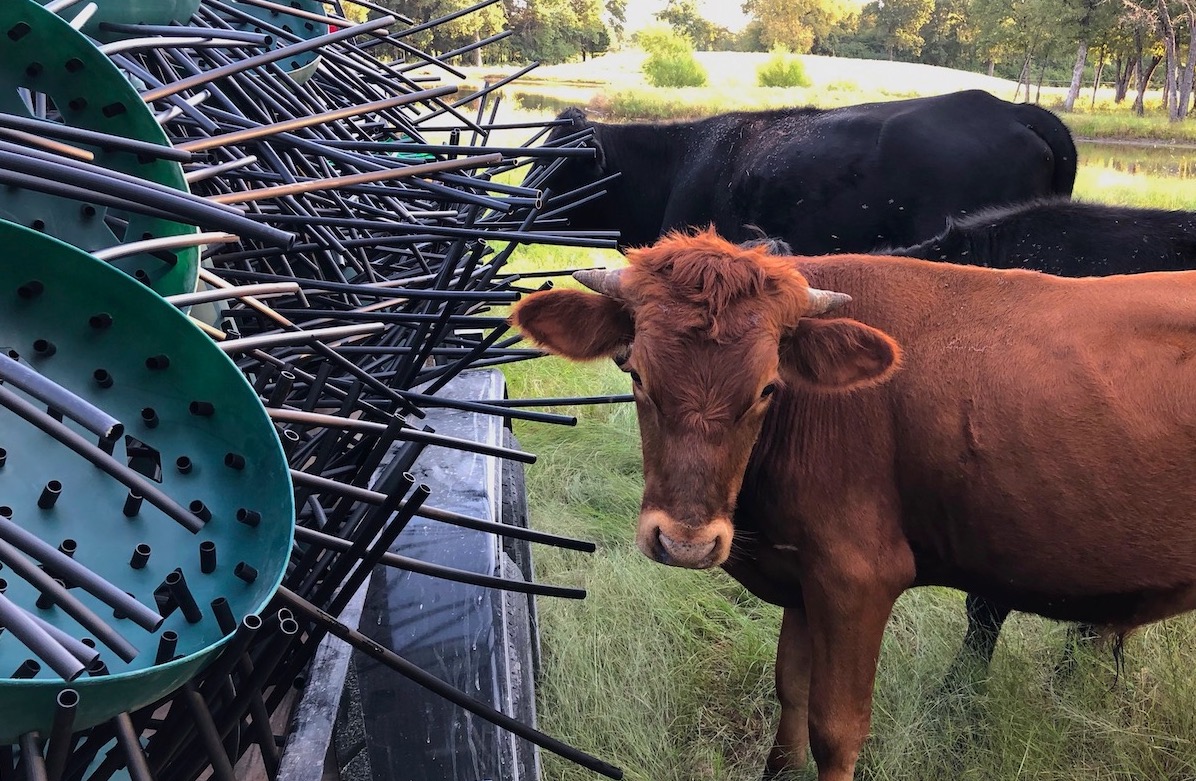If you've got a pond or a tank, as we like to call them here in Texas, that you use for watering livestock or for irrigation, you can still implement a mixed management plan that also benefits a productive fishery.
Get More Value from Your Livestock Ponds and Irrigation Tanks

Frequently ponds are created for water catchment to be utilized later for livestock or irrigation for crop cultivation. While this leads to specific management practices to ensure the pond fulfills its original purpose, you can still implement a mixed management plan that benefits a productive fishery.
Many of the same management practices that benefit ponds whose primary function is irrigation or livestock watering also help promote a healthy fishery.
While these types of ponds are primarily smaller water catchment basins (tanks) that are a ¼ to a couple of acres in size and only moderately deep, even the smallest of them can provide an afternoon's worth of recreational enjoyment for the family.
Vegetation Management is Crucial for Smaller Water Catchment and Irrigation Ponds
The primary management concern for these types of water bodies lies in vegetation control.
Allowing a tank to become overrun with aquatic weeds will limit the areas that livestock have access to drink and lead to clogging issues with irrigation lines and even quicker water loss due to evaporation. Again, because these types of ponds are relatively shallow and small in their construction, they create the perfect environment for massive aquatic weed growth.
Couple that with excrement from livestock or fertilizer runoff from the surrounding farmland increasing the nutrient load in the water column, and you've got a recipe for disaster.
Factors to Consider When Building or Improving a Farm Pond
There are several considerations to remember with improving any small farm pond. These factors will have a major impact on your ability to effectively manage your pond.
The first consideration is extremely important during an initial pond build. As your pond ages, other steps will be necessary to mitigate your pond’s shallowing slope.
Have the Right Slope for Your Farm Pond

Having the proper slope to the banks of your ponds is the first step in preventing major vegetation headaches. If the slope is too shallow, like the one pictured above, you'll constantly be battling aquatic vegetation growth.
Recommended Pond Slope for Aquatic Vegetation Control
Having a 3:1 pitch (for every three feet away from the bank line, the water depth drops one foot) allows the pond floor to become deep enough to effectively limit the amount of sunlight available to the plants in a relatively short distance.
Additionally, this slope is sufficiently aggressive to aid in controlling aquatic vegetation while also being accessible for livestock to utilize.
Don’t Overlook the Impact Livestock Can Have on Farm Ponds
Another aspect to consider is that unmanaged livestock access will slowly degrade this slope, making it more gradual in its descent to the middle of your pond and increasing the issues you will face with aquatic vegetation.
If possible, limit the access your livestock have to the pond to an area large enough to supply adequate water to the herd during peak consumption events but small enough to limit the area needing management from detrimental effects.
Get Control of the Aquatic Vegetation

If your pond is already experiencing heavy aquatic vegetation growth issues, then there are two options to manage these effects.
Options for Treating Heavy Vegetation in Small Ponds
1. Aquatic Herbicide. The first treatment option is containing the vegetation with aquatic herbicides.These herbicides perform the same task as terrestrial herbicides that you use in your yard or on cultivated crops. The major distinction between the two is that they are rated for aquatic use and not directly harmful to your fish.
Directly harmful means the herbicide itself is non toxic to your fish, but if you treat too much of the vegetation at once, you can cause an oxygen depletion that can, in turn, cause a fish kill.
Beyond this, another aspect you need to consider is the manufacturer's time interval before your livestock can drink the water, or you can use it for crop/lawn irrigation. Some manufacturers require intervals from 0 days up to 120 days depending on the herbicide's active ingredients.
2. Pond Reconstruction. The second option is to completely drain the pond, clean it out, and reconstruct it with the correct slope to the bank.
This option is sometimes the better alternative because it helps reduce the area suitable for aquatic vegetation growth around the bank and the amount of vegetation that can grow out in the middle of the pond.
As sediment collects in your pond over the years, it slowly fills in the main body. As this process makes your pond more shallow, it also reduces the pond's volume, thereby increasing the available growing area for vegetation.
You'll have to determine what is salvageable and what needs to be scrapped and redone when trying to pick between these two management tactics.
Benefits of Controlled Vegetation in Your Farm Pond
As pointed out earlier, controlling aquatic vegetation is the number one management objective, but this benefits your fishery as well.
Controlled portions of aquatic vegetation prevent your forage species from having an excess of cover to evade your predator fish. While highly complex habitat is key to a sustainable forage base, you can have too much of a good thing.
Controlling vegetation also helps to prevent the chances of oxygen depletion on those hot summer nights. When the water is already at a disadvantage for the amount of dissolved oxygen it can hold during the summer, these plants begin to use oxygen instead of producing it.
At this time, your fish and plants are quickly utilizing the already small amount of oxygen available. If this is happening in your pond, you will notice fish "piping" for air at the water's surface right at sunrise because this is when the oxygen levels are at the lowest, and the risk of a die-off is at its highest.
Protect Your Investment with an Adequate Pump and Piping
Specifically speaking of ponds designed for irrigation purposes, you need to make sure the suction pipe is adequately sized and has a sufficient protection screen around it.
These tactics will prevent some of your larger fish from plugging up the inlet or potentially ruining a pump. Additionally, having a properly sized inlet pipe will reduce the amount of force created when drawing water out of the pond, giving your fish time to feel the pull of the water and swim away before they are sucked into the pipe.
Finally, by doing this, you'll save the investment you made in the fish you stocked from being accidentally removed from your pond and you from having to figure out how to unclog a pipe 10' beneath the surface. Believe me, I've been there, and it isn't fun.
Modify Your Fishery Goals in a Multi-use Pond

Now that we have covered the management of these types of ponds for their intended purpose, let's talk about growing a nice fishery! To start, we need to clarify that since these ponds' primary purpose isn't a productive fishery, you may need to modify your goals a bit.
Farm Pond Owners Should Adjust Expectations for Growing Fish
The threat of decreasing water levels is a real concern for these types of ponds, whether it is because of drought or utilization. While there is plenty of room for your fish when the tank is full, when the water level drops due to use or evaporation, fish population densities can cause overcrowding.
This doesn't mean you can't have a productive fishery in one of these ponds; you just need to keep these water level issues in mind when setting up your fishery goals. You may want to consider thinking in terms of catch rate, not catch weight.
Think More Fish, not Bigger Fish
Many management tactics that can prevent headaches and expensive repairs to equipment can also help create a productive fishery.
Just remember, these ponds have a prior obligation. While they can lead to tons of fishing enjoyment, there is always the inherent risk of water levels dropping and your fishery suffering.
For these reasons, it's often better to amend your goals from trophy Bass production to high catch rates of quality fish, rather than risking the loss of your time and money invested in raising trophy-class fish
Contact Pond King for Professional Texas Pond and Lake Management
Remember, controlling aquatic vegetation is the number one management objective for preventing issues with pumping equipment, ensuring adequate access for livestock, and providing abundant fishing opportunities.
If you have any questions on how to manage your pond for livestock or irrigation purposes or incorporate a fishery into these types of tanks and ponds, please call or contact us today!
See y'all down at the pond.




